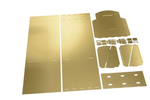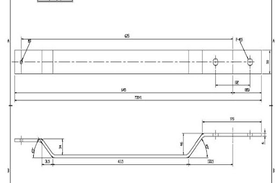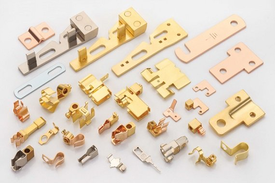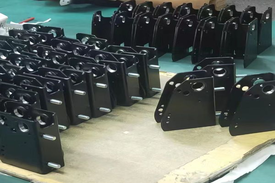Sheet Metal
Home > product > OEM sheet metal
JIAEN MFG is a leading manufacturer specializing in the customization of diverse sheet metal components. Equipped with state-of-the-art cutting, bending, welding, and finishing machinery, we ensure precise, efficient production while accommodating complex designs. We work with various materials, thicknesses, and finishes tailored to your unique specifications. Reach out to us today for high-quality solutions that align with your exact needs.
Your Reliable Partner for Custom Sheet Metal
Searching for high-quality sheet metal parts? Look no further. At Jiaen MFG, we’re proud to be your trusted provider for a wide range of sheet metal solutions. Our products are designed to cater to various industries and applications, ensuring you receive the customized parts you need, exactly when you need them.
With years of expertise in sheet metal technology, Jiaen MFG specializes in producing custom sheet metal components of all sizes, shapes, and functions. We create parts based on your precise requirements and specifications.
some products
Custom Sheet Metal Parts for Every Project

Sheet Metal parts

Sheet Metal Enclousure

Sheet Metal Parts

Sheet Metal Parts

Sheet Metal Parts

Sheet Metal Enclosure

Custom Sheet Metal needs
At Jiaen MFG, we understand the importance of precision. With our expertise in sheet metal technology, we produce custom parts in various sizes, shapes, and functions. Whatever your requirements are, we’ll make it happen.
Custom Solutions: We tailor every part to your exact specifications, ensuring it fits seamlessly into your project. You get exactly what you need, not just what’s available.
Wide Range of Materials: We offer a variety of sheet metal options to suit your unique needs.
Finishing Options: We provide a range of finishes (powder coating, painting, anodizing, electroplating, galvanizing, sandblasting, etc.) to enhance both the durability and aesthetics of your parts.
Please share the product model and your required surface treatment details. You can send us either a 2D or 3D drawing, and we’ll promptly provide you with a tailored solution.
Beyond Just a Sheet Metal Manufacturer
Custom sheet metal parts are complex, and we understand it’s tough to cover everything in one place. That’s why we’ve packed this page with comprehensive information for you to explore. To help you find exactly what you need, we’ve organized the content with a table of contents. Simply click on a link, and it will take you straight to the section you’re interested in.
General Applications For Sheet Metal
Sheet metal components are widely used across various industries due to their adaptability and ability to be shaped into different forms. Below are some of the key industries that rely on sheet metal parts:
- Automotive Industry: Sheet metal is essential in manufacturing car bodies, hoods, doors, trunks, exhaust systems, and more.
- Aerospace Industry: Used for creating wings, fuselages, access doors, and other critical components.
- Electronics Industry: Utilized in making housings and frames for computers, smartphones, televisions, stereos, and other electronic devices, as well as fixtures for circuit boards.
- Communication Industry: Essential for producing housings and brackets for communication devices, including base station equipment, network switches, and other related products.
- Home Appliances Industry: Used to fabricate the outer casing and internal structures for appliances like washing machines, refrigerators, air conditioners, microwave ovens, and more.
- Construction Industry: Vital for making roofing materials, ventilation systems, door and window components, and other construction-related products.
- Machinery Manufacturing Industry: Plays a crucial role in manufacturing parts like machine frames, protective covers, and components for industrial robots, automated lines, pumps, fans, and other machinery.
- Energy Industry: Used for creating brackets, housings, and other components in the production of solar, wind, and traditional energy equipment.
- Medical Equipment Industry: Used in the construction and exterior design of diagnostic equipment, surgical instruments, hospital beds, and other medical products.
Main Process for Sheet Metal
The sheet metal manufacturing process begins with designing the part using computer-aided design (CAD) software to generate precise drawings and models. Afterward, the appropriate materials are chosen based on the design requirements and are cut into basic shapes, typically through methods like laser cutting or waterjet cutting. Next, the part is formed into its final shape through processes such as stamping, bending, and other techniques. If needed, welding or other joining methods are used to assemble the part. To enhance both the appearance and durability, surface treatments such as buffing, painting, or plating are applied. After performing quality inspections to ensure each part meets the required standards, the part is packaged and prepared for shipment, completing the production process.

cutting
- Begin with precision CAD design of your parts, mapping out machining sequences to align with your dimensional requirements and production goals.
- Select optimal sheet metal grades (stainless steel, aluminum, or carbon steel) and cut blanks to exact dimensions, ensuring material readiness for downstream operations.
- Program critical parameters—punch force, shear speed, and tool positioning—based on your part’s thickness and geometry to maintain accuracy.
- Load validated programs into CNC controls, enabling automated material positioning, punching, and shearing for consistent first-pass quality.

stamping
- Develop 3D mold designs using CAD software, tailored to your part’s specifications to ensure precise form and function.
- Fabricate stamping dies using CNC machining, EDM, and grinding equipment, ensuring tooling durability for high-volume runs.
- Select sheet metals matched to your application needs—from corrosion-resistant stainless steel to lightweight aluminum alloys.
- Prep materials with precision cutting, then install dies into punch presses and fine-tune parameters (press force, stroke, speed) for seamless tool-machine integration.
Execute production runs where sheets are cut, formed, or stretched into finished parts; for high-volume needs, progressive dies and auto-feed systems accelerate throughput without compromising quality.

bending
- Create detailed CAD drawings to define bend lines, angles, and tolerances critical to your assembly fit.
- Engineer bending sequences and machine settings based on material type, thickness, and required angles—ensuring no distortion or stress fractures.
- Choose compatible top and bottom dies, then set clamp force, bend depth, and die clearance to match your metal’s properties
Position sheet metal precisely between dies, execute bends along specified lines, and repeat in planned sequence for multi-angle components.

welding
- Design weld joints engineered to withstand your operational loads, selecting processes (arc, gas-shielded, or laser welding) based on material compatibility and joint type.
- Prep surfaces by removing oils, rust, or coatings to ensure strong, defect-free bonds.
- Preheat materials as needed to reduce post-weld stress and distortion in high-strength alloys.
Clamp components with micron-level accuracy during welding, monitoring current, voltage, and travel speed in real time to maintain weld integrity.

riveting
- Select rivet sizes and materials (aluminum, steel, or copper) matched to your material thickness and strength requirements.
- Determine rivet placement and quantity based on structural needs, ensuring uniform load distribution across joints.
- Clean mating surfaces to remove contaminants that could weaken connections.
Install compatible dies onto riveting machines, set pressure for smooth penetration, position prepped parts, and activate presses to form secure, permanent connections.

finishing
- Clean surfaces using solvents, ultrasonic cleaners, or industrial degreasers to remove machining residues and ensure coating adhesion.
- Deburr sharp edges to prevent assembly injuries and equipment damage.
- Roughen surfaces via sanding or bead blasting to optimize coating bonding for paints or platings.
- Apply finishes tailored to your needs:
- Electroplating: Deposit metal layers via electrolytic baths for conductivity or corrosion resistance.
- Anodizing: Create protective oxide layers on aluminum parts using controlled electrolysis.
- Powder coating: Apply durable, uniform powder finishes cured in ovens for scratch and chemical resistance.
- Painting: Add primers for corrosion protection, followed by topcoats for color consistency and aesthetics.

Inspection & quality control
- Conduct first-article inspections on initial production parts, verifying dimensions, material properties, and finishes against your CAD specs.
- Perform in-process spot checks during cutting, bending, and welding—using calipers, CMMs, and optical scanners to catch deviations early.
- Test surface treatments with film thickness gauges, salt spray testers, and adhesion tests to ensure durability.
- Execute final integrity checks on welds, joints, and assembly fit; for critical components, conduct functionality testing to validate performance under real-world conditions.
Verify packaging readiness, ensuring parts are damage-free before protective wrapping.

assembling
- Analyze assembly drawings to map component connections and optimal build sequences, maximizing efficiency and accuracy.
- Develop assembly workflows that minimize handling time while ensuring proper part alignment.
- Position sheet metal components per drawings, secure temporarily with clamps, then fasten permanently via screws, rivets, welding, or adhesives.
- Validate each connection for tightness and alignment, then perform functional testing on assembled units—checking movement, stability, and compatibility with mating parts.
Apply final surface treatments and clean assemblies to remove fingerprints or assembly residues.

Packaging & Shipping
- Conduct final inspections to confirm part dimensions, quantity, and finish quality before packaging.
- Apply protective films or foam to prevent scratches on polished or painted surfaces.
- Include desiccants and moisture barriers for humidity-sensitive parts, preventing rust during transit.
- Use custom foam inserts, bubble wrap, or anti-vibration shims to prevent in-transit movement and damage.
Pack in cartons, crates, or pallets sized to your parts; secure large/heavy items with stretch wrap and straps.
Fill voids with foam peanuts or paper to stabilize loads, then coordinate shipping via land, sea, or air—with full documentation for streamlined receiving and compliance.
Estimated Cost Analysis For Sheet Metal
Final costs are determined by your unique project needs: custom fabrication steps, raw material specifications, local regulatory fees, and transportation logistics. Take a full container shipment of sheet metal parts as an example—pricing shifts to reflect these variables, ensuring alignment with your budget and requirements.

High-quality raw material procurement (matched to your strength, corrosion resistance, or weight requirements) Complete processing workflows, including precision cutting, bending, stamping, and forming—each step optimized to meet your design tolerances and structural needs
$8,300
When shipping to destinations like the U.S., freight costs are influenced by key variables: Route distance and current fuel surcharges Vessel capacity utilization and seasonal demand fluctuations Global shipping stability (port congestion, geopolitical factors, etc.) Rates fluctuate with market conditions, but you’ll receive transparent upfront estimates aligned with your delivery timeline to avoid budget surprises.
$2,500
To ensure full cost visibility, factor in these supplementary expenses: Customs Duties & Taxes: Calculated based on your destination’s tariff codes and trade agreements—we provide HS code guidance to streamline compliance and optimize costs. Transit Insurance: Essential coverage for loss or damage during shipping, with flexible options tailored to your order’s value and risk profile. Warehousing: Short-term storage fees if staging is needed pre-delivery, with competitive rates for extended holding if your production schedule requires it. Last-Mile Logistics: Inland transportation (trucking, rail) and terminal handling charges at the destination port, coordinated to align seamlessly with your receiving timeline.
$1,100The Process Flow & Duration Estimation
Your project timeline depends on custom complexity, process steps, specific requirements, order volume, and shipping logistics. Here’s a clear breakdown to help plan your production schedule:
Step 1: Engineering Design & DFM Review (3-7 days)
This phase starts with translating your requirements into detailed CAD drawings, paired with a manufacturability analysis to ensure designs align with production capabilities. Technical feasibility checks address factors like material compatibility, bend radii, and tolerance limits—critical for avoiding delays later. Timeline adjusts based on design complexity and the need to resolve technical challenges.

Step 2: Prototyping & Sample Validation (7-14 days)
After design approval, precision prototypes are produced to test form, fit, and function. This stage validates manufacturing processes and identifies any adjustments needed for mass production. The timeline accounts for sample production, testing, and potential revisions—critical for ensuring bulk runs meet your standards.

Step 3: Payment Confirmation (within 1 day)
Payment terms are finalized based on your agreement, with options ranging from deposit structures to full payment upon sample approval. This step ensures production can start without delays once samples are signed off.

Step 4: Bulk Production (30-45 days)
With prototypes approved, full-scale manufacturing begins. Timeline depends on order volume, process complexity (e.g., welding, finishing), and production line efficiency. Large orders or parts requiring specialized processes may extend this phase, but we optimize workflows to meet your deadlines.

Step 5: Shipping & Logistics (10-45 days)

How to Slash Lead Times for Your Custom Sheet Metal Parts
The Basic Knowledge About Sheet Metal
Sheet metal stands as a foundational material across industries, valued for its versatility and ability to be shaped into precise components that drive your production needs.
As a core raw material in metal fabrication, sheet metal comes in thin, flat sheets designed for easy cutting, bending, and forming into custom shapes. It’s available in a range of metals to match your application requirements: stainless steel for corrosion resistance, aluminum for lightweight strength, copper for conductivity, and galvanized steel for durability. The right material choice depends on your priorities—whether strength, weight savings, environmental resistance, or cost efficiency—ensuring the final part performs in your specific industry, from automotive and aerospace to construction and appliance manufacturing.
Sheet metal processing leverages advanced techniques to turn raw material into functional parts. Cutting is executed with laser, plasma, or waterjet systems for micron-level precision, ensuring clean edges that align with your design specs. Bending uses hydraulic press brakes to fold metal to exact angles, following your engineering drawings with consistent accuracy. Modern fabrication also integrates stamping for high-volume forming, welding for structural joins, and powder coating for protective, aesthetic finishes—all tailored to meet your functional and visual requirements. These efficient, precise processes enable rapid production without compromising the quality your end products demand.
The Common Pitfalls When Purchasing
Sourcing sheet metal components can be a critical challenge for your production timeline and budget. Without careful planning, you risk overspending, facing delays, or receiving parts that fail to meet your standards. Being aware of these common pitfalls helps streamline your procurement process and protect your operations. Here’s what to watch for:
- The Low-Price Temptation
- Communication Gaps
- Inadequate Quality Controls
- Unreliable Delivery Schedules
- Overpromised Technical Capabilities
- Ambiguous Contract Terms
A Brief Self-Nomination, Why Choose Jiaen MFG?
When it comes to sheet metal fabrication, you need a partner who delivers precision, reliability, and results—no exceptions. With over a decade of expertise serving diverse industries, we’ve built our reputation on turning your specifications into high-performance parts that keep your production on track.
- Tech-Driven Quality – Advanced CNC machinery and rigorous QA protocols ensure consistent precision, from prototype to production.
- Tailored Solutions – We design around your unique requirements, optimizing for material efficiency, functionality, and cost.
- On-Time Reliability – Streamlined workflows and proactive communication mean your parts arrive when your schedule demands them.
- Dedicated Support – Our team stays with you from design consultation to post-delivery, resolving issues before they impact your operations.
- Value-Focused Pricing – Transparent costs that balance quality and affordability, with no hidden fees to derail your budget.
The FAQs About Sheet Metal
As an international buyer, navigating sheet metal procurement requires clarity on critical details that impact your project success. These FAQs address key questions to help you make informed decisions—covering material selection, processing methods, design optimization, and supplier evaluation.
What factors should I consider when choosing sheet metal materials for my application?
Material selection depends on your functional requirements: stainless steel offers corrosion resistance for outdoor or high-moisture environments; aluminum reduces weight for aerospace or automotive use; carbon steel provides high strength for structural components. Consider factors like operating temperature, load-bearing needs, and cost targets—we can help match materials to your specific use case.
How do I ensure my sheet metal design is manufacturable and cost-effective?
Focus on design for manufacturability (DFM) principles: keep bend radii consistent with material thickness, avoid overly complex geometries, and standardize hole sizes. Sharp internal corners or inconsistent wall thicknesses can increase production time and costs. Sharing your CAD files early for a DFM review helps identify optimization opportunities before tooling begins.
What tolerance levels can I expect for custom sheet metal parts?
Typical tolerances range from ±0.1mm for simple bends to ±0.05mm for critical dimensions using precision laser cutting. Tolerance capabilities depend on material thickness, process type, and part complexity. For high-precision applications (like aerospace components), we can achieve tighter tolerances through specialized machining and inspection processes.
How does surface treatment affect the durability and cost of sheet metal parts?
Surface treatments like powder coating, galvanizing, or anodizing enhance corrosion resistance and extend part lifespan—critical for outdoor or industrial use. While treatments add to upfront costs, they reduce long-term replacement expenses. The cost varies by treatment type: powder coating is cost-effective for large volumes, while anodizing offers premium protection for aluminum parts.
What documentation should I request from a sheet metal supplier to verify quality?
Ask for material certificates (COA) to confirm alloy composition, dimensional inspection reports (using CMM data), and process validation records for critical steps like welding or bending. For regulated industries, request ISO 9001 or industry-specific certifications (e.g., IATF 16949 for automotive). A reliable supplier will provide these documents upfront to demonstrate compliance.
How can I estimate lead times for custom sheet metal orders?
Lead times depend on part complexity, order volume, and finishing requirements: simple parts with standard finishes may take 2–3 weeks; complex assemblies or large volumes can take 4–6 weeks. Prototyping typically takes 7–10 days. Always factor in buffer time for design revisions and shipping—we provide detailed timelines with milestones to keep your project on track.
What shipping and packaging considerations are critical for international sheet metal orders?
Ensure parts are packaged with anti-corrosion measures (desiccants, vapor barriers) to prevent rust during transit. Palletized shipments with secure strapping reduce damage risk for large parts. For customs clearance, request accurate HS codes and commercial invoices detailing material composition. We coordinate with freight partners to optimize packaging and provide tracking for full visibility.
How do I resolve quality issues if received parts don’t meet specifications?
Start by sharing detailed photos and inspection reports with the supplier to document discrepancies. A reputable partner will offer a root-cause analysis and corrective action plan—whether reworking parts, replacing defective units, or adjusting production processes. Clear contract terms outlining quality standards and liability help streamline resolution, so ensure these are defined upfront.














